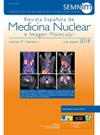一种基于地中海饮食的低致敏固体食物,用于胃排空伽玛图。《清空所有人的饮食》
IF 1.6
4区 医学
Q3 RADIOLOGY, NUCLEAR MEDICINE & MEDICAL IMAGING
Revista Espanola De Medicina Nuclear E Imagen Molecular
Pub Date : 2025-07-01
DOI:10.1016/j.remn.2024.500093
引用次数: 0
摘要
目的:建立低过敏性地中海饮食对胃排空造影(GES)的正常值和标准化。材料和方法在健康志愿者的前瞻性队列中,我们对[99Tc]TcDTPA2 -标记的低过敏性膳食(鸡蛋、土豆、大米和橄榄油)进行了GES。在0、30、60、110、120、130、180、230、240、250分钟同时获取前后位图像。在人口统计学数据和胃潴留值之间进行横断面分析。采用分数协方差分析模型观察各测量值随时间的变化。结果共纳入50例受试者,其中女性29例。60、120、180、240 min胃潴留率的平均值为51.40±8.63(36.5-66.1),标准差为21.66±9.40(6.5-38.2),7.58±5.77(1.5-19.1),2.94±2.08(1-7.3),标准差为5-95。在几乎所有的收购中,男性参与者的胃排空速度都明显快于女性。在广义线性模型中,男性参与者和吸烟者的胃潴留值显著降低(男性系数- 4.818,95% CI: - 7.24至- 2.39,P <;措施;吸烟者系数为- 3.484,95% CI: - 6.29 ~ - 0.67, P <;. 05)。结论:本研究基于共识建议和地中海饮食,以低过敏性固体餐为标准,建立了GES的正常值;适用于大多数对其他膳食成分过敏或敏感的患者。本文章由计算机程序翻译,如有差异,请以英文原文为准。
Una comida sólida hipoalergénica para la gammagrafía de vaciado gástrico basada en la dieta mediterránea. «Una dieta para vaciarlos a todos»
Aim
We aim to establish normal values and standardize a hypoallergenic and Mediterranean diet for gastric emptying scintigraphy (GES).
Material and methods
In a prospective cohort of healthy volunteers, we performed GES of a [99Tc]TcDTPA2− labelled hypoallergenic meal (egg, potato, rice and olive oil). Anterior and posterior images were simultaneously acquired at 0, 30, 60, 110, 120, 130, 180, 230, 240 and 250 minutes. Cross-sectional analysis was performed between demographic data and gastric retention values. A score covariance analysis model was used to observer changes between measurements over time.
Results
50 participants (29 women) were included. Mean values and standard deviation (5-95th) for gastric retention percentages at 60, 120, 180, 240 minutes were 51.40 ± 8.63 (36.5-66.1), 21.66 ± 9.40 (6.5-38.2), 7.58 ± 5.77 (1.5-19.1) and 2.94 ± 2.08 (1-7.3), respectively. Male participants had a significative faster gastric emptying compared to women in practically all the acquisitions. Male participants and smoker participants generated a significative decrease of gastric retention values in generalized linear model (male coefficient −4.818, 95% CI: −7.24 to −2.39, P < .001; and smoker coefficient of −3.484, 95% CI: −6.29 to −0.67, P < .05).
Conclusion
This study standardizes and establishes normal values for GES with the first hypoallergenic solid meal based on consensus recommendations and a Mediterranean diet; suitable for most patients with allergic or sensitive-conditions to other meal components.
求助全文
通过发布文献求助,成功后即可免费获取论文全文。
去求助
来源期刊

Revista Espanola De Medicina Nuclear E Imagen Molecular
RADIOLOGY, NUCLEAR MEDICINE & MEDICAL IMAGING-
CiteScore
1.10
自引率
16.70%
发文量
85
审稿时长
24 days
期刊介绍:
The Revista Española de Medicina Nuclear e Imagen Molecular (Spanish Journal of Nuclear Medicine and Molecular Imaging), was founded in 1982, and is the official journal of the Spanish Society of Nuclear Medicine and Molecular Imaging, which has more than 700 members.
The Journal, which publishes 6 regular issues per year, has the promotion of research and continuing education in all fields of Nuclear Medicine as its main aim. For this, its principal sections are Originals, Clinical Notes, Images of Interest, and Special Collaboration articles.
 求助内容:
求助内容: 应助结果提醒方式:
应助结果提醒方式:


